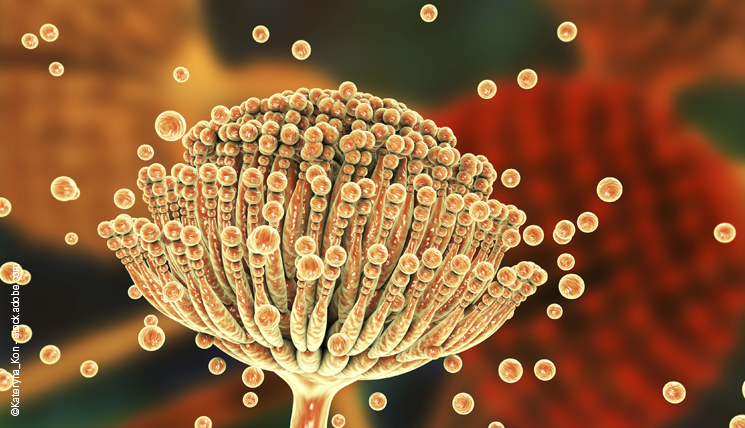Aspergillus spp. are ubiquitous moulds which are found in the soil, compost, or on humid walls. They form single-celled spores that spread through the air and of which every person inhales hundreds every day. Their concentration is especially increased in the summer. In people with an intact immune system, inhalation of the spores has usually no consequences. However, if people are permanently exposed to them, e.g. in an apartment affected by mould, hypersensitivities or allergic reactions may occur. Individuals with a weakened immune system lack an adequate immune response to the spores. Starting from the lung, the pathogens spread into the body. They often affect the central nervous system, eyes, heart, kidneys and the skin. Consequently, a life-threatening form of aspergillosis may develop. This is called invasive aspergillosis (IA) and is accompanied by unspecific symptoms such as fever or inflammatory reactions. 50–90% of IA cases are fatal, especially if the central nervous system is affected by the infection. Particularly patients with blood disorders and/or tumour diseases, who have undergone bone marrow transplantation, are considered to be high-risk persons for IA. Also other immunodeficiencies, such as HIV infections or treatment with immunosuppressives, e.g. glucocorticoids, may favour Aspergillus infection. Over the last years, an increasing number of infections were observed in patients in intensive care who contracted the disease during their stay in the hospital.
Aspergillus antigen detection
IA can be diagnosed by cultivation and microscopic investigation of the mould. Another established method is the detection of specific pathogen components (Aspergillus antigen) in bodily fluids. The procedure delivers results much quicker than cultivation, which is why the detection is especially helpful for an early diagnosis. Therefore, the determination of Aspergillus antigen was included in renowned diagnostic guidelines as a criterion for “probable IA” (guidelines of the European Organization for Research and Treatment of Cancer (EORTC) and National Institute of Allergy and Infectious Diseases Mycoses Study Group (MSG) [1]) and recommended as a regular blood screening test in high-risk patients.
The new Aspergillus Antigen ELISA provides in vitro determination of galactomannoprotein, a glycoprotein from the cell wall of different Aspergillus spp., in serum or fluid samples of the lung (bronchoalveolar lavage samples). “We designed the test exactly to suit the current guidelines” says Victor Herbst, Director of the Department of Antigen ELISA development. Therefore, the test can be used for both screening and monitoring of patients at risk. According to a current study, EUROIMMUN’s Aspergillus Antigen ELISA shows similarly high sensitivity and specificity to those of another commercial test [2]. Since both tests use the same units and threshold values, their results can be directly compared with each other. “Moreover, our test can be evaluated not only semiquantitatively, but also quantitatively (in pg/ml, via a 6-point calibration curve) and processed semi-automatically using the EUROIMMUN Analyzer. “This makes it easier for our customers to integrate the ELISA into their test portfolio” adds the developer.
[1] De Pauw B et al., Clin Infect Dis 46(12): 1813–1821 (2008) [2] Dichtl K et al, J Clin Microbio 57(7) (2019)
